Vertical gardening is a popular and innovative way to maximize your outdoor space and grow a variety of plants, herbs, and vegetables in a vertical arrangement. By utilizing vertical structures, such as trellises, arches, and cages, you can create a stunning and efficient garden that is perfect for small spaces, balconies, and patios. In this section, we will explore the possibilities of what you can grow in a vertical garden and provide you with some creative ideas to get started.
Key Takeaways:
- Vertical gardening is a space-saving technique that allows you to grow a variety of plants in limited areas.
- Benefits of vertical gardening include increased yields, reduced plant problems, improved sun exposure, and ease of care and harvesting.
- Recommended plants for vertical gardening include vining vegetables, herbs, and fruits that are well-suited for vertical growth.
- Different types of vertical structures, such as trellises, arches, and cages, can be used to support climbing vegetables in a vertical garden.
- Specific examples of fruits and vegetables that can be successfully grown in a vertical garden include tomatoes, cucumbers, peas, beans, squash, melons, eggplants, and more.
- Practical tips and techniques for successful vertical gardening include proper watering, sunlight requirements, pruning, and pest control.
- Creative DIY ideas for vertical gardening include living walls, trellis panels, vegetable arches, and more.
- Vertical gardening is particularly beneficial for small spaces, allowing individuals to grow a variety of plants in limited areas.
- Maintenance and care for vertical gardens include watering schedules, fertilization, pruning, and pest management.
- Common challenges in vertical gardening include watering needs, soil requirements, and choosing appropriate plants for specific growing conditions.
- Vertical gardening can also be done indoors, with proper consideration for lighting and humidity.
- Vertical gardening provides a versatile and efficient way to maximize outdoor space and grow a wide range of plants, herbs, and vegetables.
The Benefits of Vertical Gardening
Vertical gardening offers several advantages that make it an appealing option for gardeners, especially those with limited space or looking for creative design solutions. By utilizing structures such as trellises, poles, and cages, gardeners can make the most of their vertical space and maximize their growing area. Here are some of the key benefits of vertical gardening:1. Increased Yields: One of the primary benefits of vertical gardening is the ability to grow more plants in a smaller space, leading to increased yields. By using vertical structures, gardeners can take advantage of the upward growth of plants, allowing them to grow more plants in the same square footage.2. Reduced Plant Problems: When plants are grown vertically, they are lifted off the ground, reducing the risk of diseases caused by soil-borne pathogens. Vertical gardening also improves air circulation around the plants, helping to prevent the development of fungal diseases like powdery mildew and rust. Additionally, pests and insects are more visible on vertical plants, allowing for timely detection and control.3. Improved Sun Exposure: Vertical gardening allows plants to receive better sunlight exposure. By training plants to grow upwards on trellises or stakes, more leaf surface is exposed to sunlight, promoting healthier growth and better fruit development.4. Ease of Care and Harvesting: Vertical gardening makes it easier for gardeners to care for their plants and harvest their crops. With plants growing vertically, there is less bending and kneeling required, making it more comfortable and accessible for individuals with physical limitations. Additionally, harvesting becomes simpler as the fruits and vegetables are more visible and easier to reach.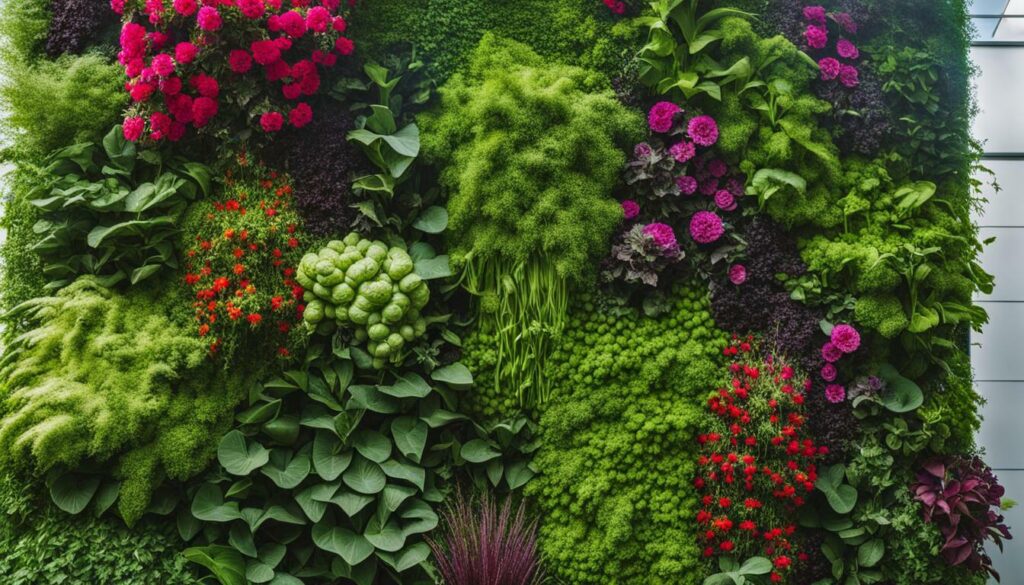 By understanding the benefits of vertical gardening, gardeners can make informed choices about their gardening methods and maximize their growing potential. Whether you have a small space, want to improve sun exposure, or simply prefer a more organized and accessible garden, vertical gardening can provide a versatile and efficient solution.
By understanding the benefits of vertical gardening, gardeners can make informed choices about their gardening methods and maximize their growing potential. Whether you have a small space, want to improve sun exposure, or simply prefer a more organized and accessible garden, vertical gardening can provide a versatile and efficient solution.Vertical Gardening Tips for Success
To ensure successful vertical gardening, here are some tips to keep in mind:- Choose the right plants: Select vining, climbing, or sprawling varieties that are well-suited for vertical growth. Some recommended plants include pole beans, climbing peas, vining tomatoes, and cucumbers.
- Provide proper support: Use sturdy trellises, poles, or cages to support the plants as they grow. Match the structure with the plant’s characteristics and weight.
- Ensure adequate sunlight: Most vegetables require 6 to 8 hours of direct sunlight, so pick a location that receives sufficient sunlight throughout the day. Consider the angle and orientation of the sun when deciding on the placement of your vertical garden.
- Water and fertilize regularly: Vertical gardens may require more frequent watering due to increased sun exposure. Consider using a micro or drip irrigation system coupled with a timer for efficient water delivery. Fertilize plants as needed to promote healthy growth.
- Monitor for pests and diseases: Regularly inspect your vertical garden for signs of pests or diseases. Early detection and intervention can help prevent the spread and minimize damage to your plants.
| Recommended Plants for Vertical Gardening | Sun Requirements |
|---|---|
| Pole Beans | Full sun |
| Climbing Peas | Full sun |
| Vining Tomatoes | Full sun |
| Cucumbers | Full sun to partial shade |
Choosing the Right Plants for Vertical Gardening
When it comes to vertical gardening, selecting the right plants is crucial for ensuring successful growth and maximizing the use of vertical space. Vining, rambling, and sprawling plants are perfect for vertical gardens as they can be easily trained to grow up and off the ground, saving horizontal space and creating a stunning display. Here are some of the best plants for vertical gardening:
- Zucchini: Zucchinis are versatile vegetables that thrive when grown vertically. By training them to grow up a trellis or cage, you can save space and prevent disease by keeping the fruits off the ground.
- Tomatoes: Both determinate and indeterminate varieties of tomatoes can be grown vertically. By using cages, stakes, or trellises, you can promote better airflow, reduce disease risk, and make harvesting easier.
- Cucumbers: Cucumbers have long vines that naturally cling to trellises or stakes. Growing them vertically not only saves space but also keeps the fruits off the ground, reducing the risk of pests and diseases.
- Peas: Peas are cool-season crops that thrive when trained to climb a trellis or netting. Growing peas vertically improves air circulation, saves space, and makes harvesting a breeze.
- Pole Beans: Like peas, pole beans are natural climbers and can be easily trained to grow on trellises or netting. Vertical growth saves space and promotes healthier, more productive plants.
- Squash: Growing squash vertically can be challenging due to the weight of the fruits, but with proper support, it can be done. Vertical growth improves air circulation and reduces the risk of rotting and pest infestation.
- Melons: Smaller varieties of melons can be grown vertically with strong support. Vertical growth keeps the fruits off the ground and promotes better air circulation, leading to healthier plants and potentially increased yield.
- Eggplant: With proper care and support, eggplants can thrive in a vertical garden. Vertical growth keeps the fruits off the ground, reduces the risk of rotting and pests, and makes harvesting easier.
When selecting plants for vertical gardening, it is essential to consider their light requirements. Most vegetables need 6 to 8 hours of direct sunlight, so choose a surface that faces the midday or afternoon sun for optimal growth. Additionally, ensure that the chosen plants can be easily trained to grow vertically and provide proper support for their weight.
Types of Vertical Gardening Structures
In addition to trellises, tripods, arches, and pergolas, there are various structures that can be used for vertical gardening. The choice of structure depends on the characteristics of the plants being grown. For leafy plants with tendrils, such as pole beans and sweet peas, trellises made from woody pruning are suitable. More substantial plants like grapevines benefit from sturdier structures like arches or pergolas. It is essential to ensure that the structure can support the weight of the mature plants and is securely anchored to prevent toppling over.
Vertical gardening opens up endless possibilities for creative DIY projects. One popular idea is creating a living wall by attaching a trellis panel to a wall and planting pots of herbs, vegetables, and flowers. Another option is building a walk-through vegetable arch using galvanized metal uprights and cattle panels, allowing climbing crops like beans, cucumbers, and squash to grow and make for easy picking.
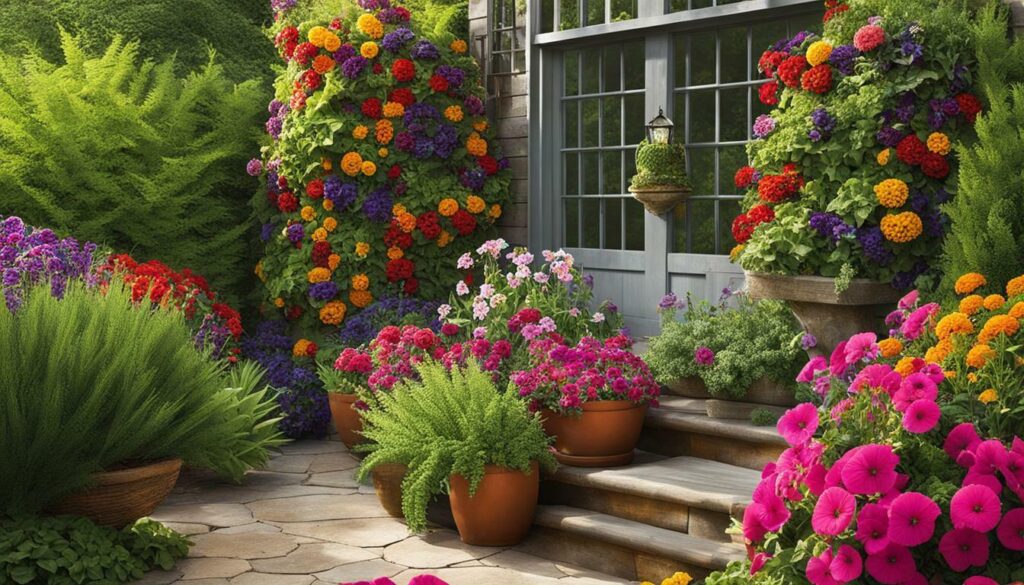
Vertical gardening is particularly beneficial for small spaces, such as balconies, patios, and small yards. It allows individuals to make the most of limited areas and enjoy a variety of plants. With proper care and maintenance, vertical gardens can thrive and provide an abundance of fresh produce.
When it comes to choosing the right plants for vertical gardening, consider the specific needs of each plant, provide proper support, and ensure they can be easily trained to grow vertically. By selecting the right plants and structures, you can create a beautiful and productive vertical garden.
| Vegetable | Varieties |
|---|---|
| Zucchini | ‘Black Beauty’, ‘Golden’, ‘Green Machine’ |
| Tomatoes | ‘Roma’, ‘San Marzano’, ‘Cherokee Purple’ |
| Cucumbers | ‘Marketmore’, ‘Lemon’, ‘Picklebush’ |
| Peas | ‘Sugar Snap’, ‘Snow Pea’, ‘Wando’ |
| Pole Beans | ‘Blue Lake’, ‘Kentucky Wonder’, ‘Scarlet Runner’ |
| Squash | ‘Crookneck’, ‘Butternut’, ‘Spaghetti’ |
| Melons | ‘Watermelon’, ‘Cantaloupe’, ‘Honeydew’ |
| Eggplant | ‘Black Beauty’, ‘Japanese’, ‘Ichiban’ |
FAQs on The Best Plants for a Vertical Vegetable Garden
- What are some of the best plants for a vertical vegetable garden?
- Can all vegetables be grown vertically?
- What kind of support do I need for a vertical vegetable garden?
- Can vertical gardening improve the yield of my vegetables?
- How do I water a vertical vegetable garden?
- Is vertical gardening suitable for small spaces?
- Can vertical gardens be grown indoors?
- What are some challenges of vertical vegetable gardening?
- Do I need any special soil for vertical gardening?
- How often should I fertilize my vertical garden?
Choosing the right plants for vertical gardening is essential for creating a thriving and productive garden. With careful selection and proper support, you can enjoy an abundant harvest and maximize the use of vertical space in your garden.
Designing Vertical Structures for Climbing Vegetables
Building sturdy and functional vertical structures is essential for supporting the growth of climbing vegetables in a vertical garden. These structures provide the necessary support for the plants to climb and grow, maximizing space and allowing for easier maintenance and harvesting. Trellises, arches, cages, and other types of structures can be used to create a vertical garden that is both productive and visually appealing.
When designing vertical structures for climbing vegetables, it is important to consider the specific needs of the plants. Some vegetables, such as pole beans and cucumbers, have long vines that require a strong and durable trellis for support. Other plants, like tomatoes, may need sturdier structures, such as cages or stakes, to bear the weight of their fruits.
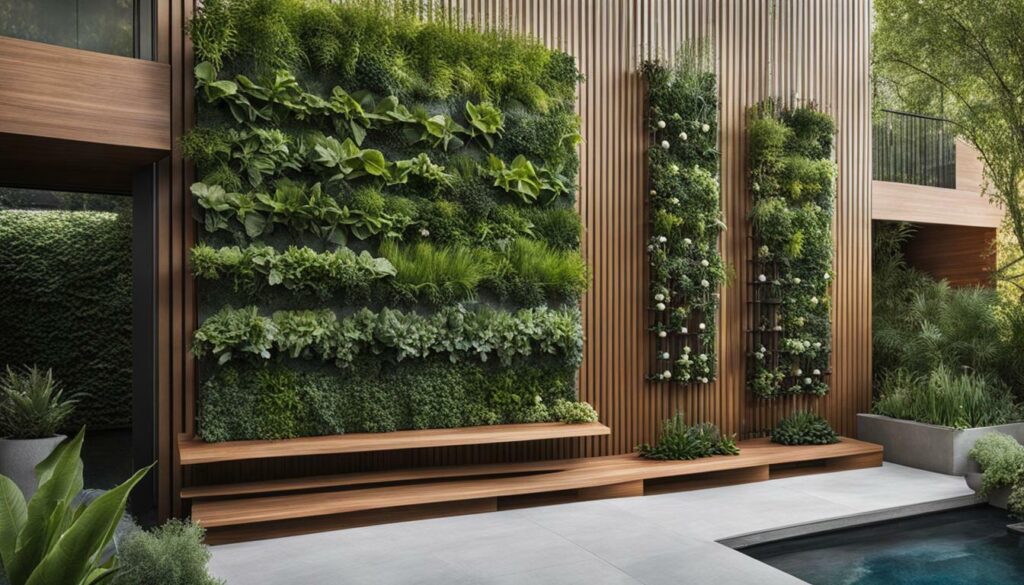
It is also important to match the structure with the plant’s characteristics. Leafy plants with tendrils, like pole beans and sweet peas, do well climbing up trellises made from woody pruning. More substantial plants, such as grapevines, may benefit from arches or pergolas. However, it is crucial to ensure that the structure can accommodate the weight of the mature plant and is securely anchored to prevent toppling over.
| Plant | Recommended Structure |
|---|---|
| Pole beans | Trellis |
| Cucumbers | Trellis or netting |
| Tomatoes | Cage or stake |
| Squash | Trellis or sturdy support |
By designing vertical structures that best suit the climbing vegetables being grown, gardeners can create an efficient and productive vertical garden. These structures not only provide support but also help improve air circulation, reduce disease risks, and make harvesting easier. Whether it’s a trellis, arch, cage, or other creative structure, designing with the plant’s needs in mind is key to successful vertical gardening.
Growing Fruits and Vegetables in a Vertical Garden
Vertical gardens offer a wide range of possibilities for growing delicious and nutritious fruits and vegetables, allowing you to make the most of your available space. With the right plants and structures, you can create a thriving vertical garden that not only enhances the aesthetics of your outdoor space but also provides you with a bountiful harvest.
When it comes to choosing the best plants for your vertical garden, vining vegetables and fruits are ideal candidates. These plants naturally climb and can be trained to grow up trellises, cages, or other vertical structures. Some popular examples include pole beans, cucumber, zucchini, climbing peas, and vining tomatoes.
| Plant | Varieties |
|---|---|
| Pole beans | Romano Italian, Meraviglia Venezia, Gold of Bacau |
| Cucumber | Burpee Hybrid II, County Fair 83, Dasher 11, Saladin |
| Green bean | Romano Italian, Meraviglia Venezia, Gold of Bacau |
| Lima bean | Doctor Martin, King of the Garden |
| Melon | Delicious 51, Tigger, Sleeping Beauty |
| Pea | Dual, Garden Sweet, Maestro, Sugar Snap, Super Sugar Snap |
| Squash | Acorn, Delicata, Yellow summer, Zucchini |
It’s important to choose the right structure for your climbing vegetables. Trellises, arches, and cages are popular options that provide support and guidance for the plants as they grow. Consider the characteristics of the plants and the weight they will bear when selecting the appropriate structure.
Vertical gardening also offers numerous benefits, including increased yields, improved air circulation, and easier access for maintenance and harvesting. However, it’s essential to keep in mind that vertical gardens may require more frequent watering, especially wall-mounted planters that may be affected by rain shadow. Micro or drip irrigation systems can be used to efficiently deliver water and can even be automated with timers.
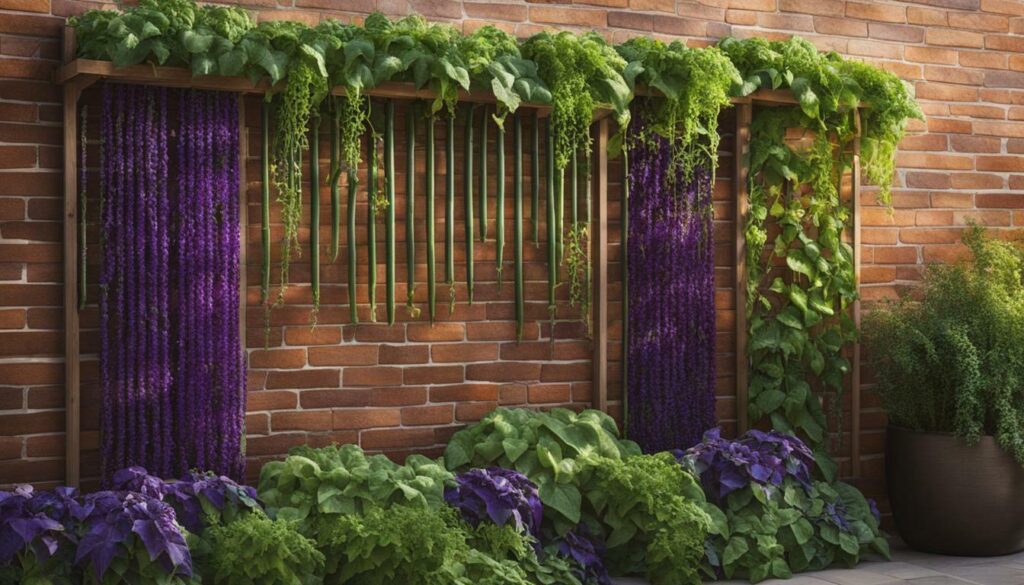
With proper care and attention, your vertical garden can be a thriving oasis of fresh produce. By selecting the right plants, providing the necessary support structures, and maintaining regular watering and pest control, you can enjoy a bountiful harvest of fruits and vegetables right in your own backyard.
Tips for Successful Vertical Gardening
To ensure the success of your vertical garden, it’s important to follow some key tips and guidelines for optimal plant growth and productivity. Here are some tips to help you get started:
- Choose the right location: Select a spot that receives at least 6 to 8 hours of direct sunlight each day. This is essential for the healthy growth of your plants.
- Provide proper support: Invest in sturdy trellises, cages, or other vertical structures that can support the weight of your climbing plants. Make sure they are securely anchored to the ground or wall to prevent them from toppling over.
- Water regularly: Vertical gardens may require more frequent watering, especially wall-mounted planters that are exposed to the rain shadow. Consider using micro or drip irrigation systems for efficient and automated watering.
- Prune and train your plants: Regular pruning helps maintain the shape and size of your plants, promotes better air circulation, and prevents overcrowding. Train your plants to grow vertically using ties, strings, or clips to guide their growth.
- Monitor for pests and diseases: Vertical gardens can be more susceptible to pest infestations and diseases due to the denser foliage and limited airflow. Regularly inspect your plants for signs of pests or diseases and take appropriate measures to control them.
By following these tips, you can create a thriving vertical garden that maximizes your growing space and yields bountiful harvests.
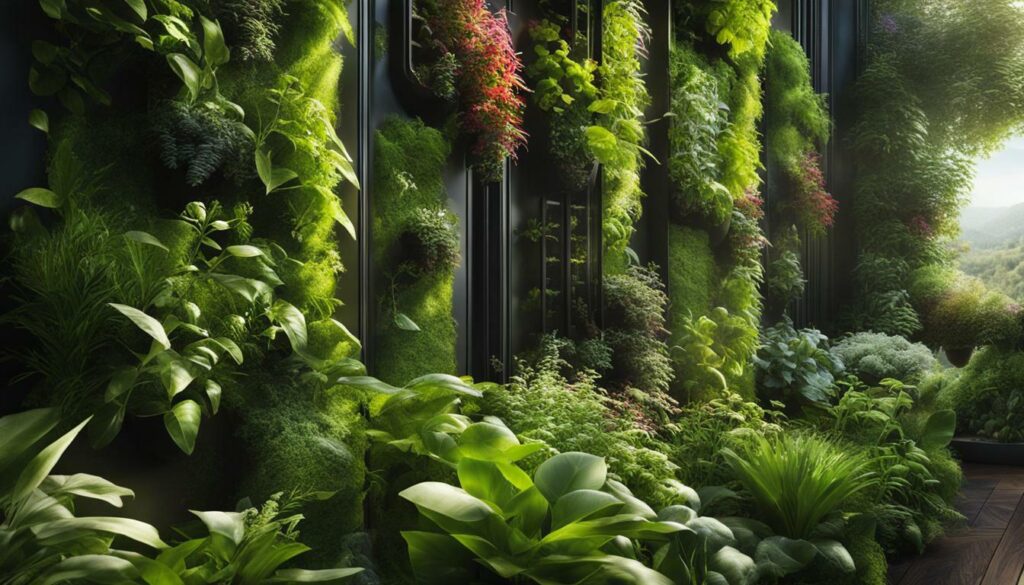
“Vertical gardening is a great way to make the most of limited space and enjoy the benefits of growing your own plants. With the right techniques and care, you can create a stunning vertical garden that not only enhances the aesthetics of your space but also provides you with a fresh and healthy harvest.”
Summary:
Vertical gardening offers numerous benefits for those with limited space or a desire to maximize their growing area. By choosing the right location, providing proper support, watering regularly, pruning and training plants, and monitoring for pests and diseases, you can create a successful vertical garden. Following these tips will help you achieve optimal plant growth and productivity while enjoying the beauty and abundance of your vertical garden.
| Recommended Plants for Vertical Gardening | Type | Sunlight Requirements |
|---|---|---|
| Pole Beans | Vegetable | Full sun |
| Climbing Peas | Vegetable | Full sun/part shade |
| Vining Tomatoes | Vegetable | Full sun |
| Squash | Vegetable | Full sun |
| Cucumbers | Vegetable | Full sun |
| Peppers | Vegetable | Full sun |
| Herbs | Herb | Varies by type |
| Flowers | Flower | Varies by type |
Source: Vegetable Seed Vault Kit – 35 Variety Pack
Creative DIY Vertical Gardening Ideas
If you’re feeling adventurous and want to personalize your vertical garden, there are plenty of DIY projects and ideas that can add a unique touch to your space. Whether you’re working with a small balcony, a patio, or even an indoor area, these creative DIY solutions will help you maximize your growing space and create a stunning vertical garden.
Living Wall
One easy way to make a vertical garden in an attractive way is a trellis panel secured onto the wall to support a range of pots planted with herbs, vegetables, and flowers. Choose an appropriate-sized panel then give it a coat of wood stain or paint to protect it and help it stand out. Drill holes into the wall with a masonry drill bit, line them with wall anchors or rawlplugs, then screw in a suitable strong L-shaped hook. Our panel below uses three. Check that the hooks are level and evenly spaced then hang up your panel.
| Plants | Varities |
|---|---|
| Pea shoots | Sugar Snap |
| Lettuce | Romaine |
| Bush beans | Blue Lake |
| Herbs | Basil, Parsley, Thyme |
Plant up or sow your pots with low-growing crops like lettuce, pea shoots, bush beans, radishes, herbs or–for a pop of color–a few flowers like violets and marigolds. Space out the pots evenly and secure them to the trellis with sturdy garden twine, wrapped two to three times around the pot to spread its weight. Don’t forget to keep plants watered so they don’t dry out. Harvest regularly and resow, replant or reconfigure your display as needed.
Vegetable Arch
You can make a productive walk-through vegetable arch using galvanized metal uprights and cattle panels. Clad with climbing crops like beans, cucumbers, and squash, the archway makes for easy picking – and a simply stunning way to turn utilitarian veggies into something really beautiful! Locate your vegetable archway somewhere sunny and sheltered. Start by digging out planting trenches either side of the arch. Next, drive home the uprights. Space the uprights to correspond with the width of the cattle panels. The trenches can then be backfilled, starting with a thick layer of nutrient-rich organic matter such as compost or well-rotted manure, followed by the excavated soil. Cut the cattle panels to size with wire cutters. Measure out enough of the panels to give an arch that’s high enough to walk beneath without having to stoop. Use zip ties to secure the panels to the posts at regular intervals, then trim off the excess to give a neat finish. If you’re using more than one section of cattle panel, slightly overlap the edge of the second section with the first then secure it in the same way.
| Vegetables | Varieties |
|---|---|
| Pole beans | Romano Italian, Meraviglia Venezia, Gold of Bacau |
| Cucumbers | Burpee Hybrid II, County Fair 83, Dasher 11, Saladin |
| Green bean | Romano Italian, Meraviglia Venezia, Gold of Bacau |
| Pea | Dual, Garden Sweet, Maestro, Sugar Snap, Super Sugar Snap |
Plant your archway trenches with your climbing vegetables. Add a mulch of organic matter once the plants are established to lock in soil moisture and gently feed them. Most plants should find their way up, but weave them into place if necessary.
 Vertical Garden with Recycled Items
Vertical Garden with Recycled Items
Another creative DIY vertical gardening idea is to repurpose everyday items and turn them into unique vertical planters. Old gutters can be transformed into a vertical herb garden by attaching them to a wall or fence. Each section of the gutter can be filled with soil and planted with different herbs. This not only saves space but also adds a touch of creativity to your vertical garden.
Old shoe organizers can also be utilized as vertical planters. Simply hang the shoe organizer on a wall or fence, fill each pocket with soil, and plant herbs or other small plants. This allows for a variety of plants to be grown in a limited space.
By thinking outside the box and repurposing items, you can create a unique and personalized vertical garden that is both functional and visually appealing.
Vertical Gardening for Small Spaces
Vertical gardening is an excellent solution for those with limited outdoor space, as it allows you to create a lush and productive garden even in the smallest of areas. By utilizing vertical structures, such as trellises, arches, and cages, you can make the most of your vertical space and grow a wide variety of plants. Whether you have a small balcony, patio, or yard, vertical gardening can provide you with the opportunity to enjoy fresh vegetables, herbs, and flowers.
When designing a vertical garden for small spaces, it is important to choose plants that are well-suited for vertical growth. Vining vegetables like pole beans, climbing peas, and vining tomatoes are excellent choices, as they can be trained to grow upwards and take up less horizontal space. Other plants that do well in vertical gardens include herbs like basil, thyme, and mint, which can be grown in vertical pots or hanging baskets.
To support your climbing vegetables and herbs in a vertical garden, you can use various structures such as trellises, arches, and cages. These structures not only provide support but also add visual interest to your garden. For smaller spaces, wall-mounted planters or vertical hanging systems can be used to maximize your growing area. Remember to position your vertical garden in a spot that receives 6 to 8 hours of direct sunlight each day to ensure optimal growth.
| Recommended Plants for Vertical Gardening: | Recommended Structures for Vertical Gardening: |
|---|---|
| – Pole beans | – Trellises |
| – Climbing peas | – Arches |
| – Vining tomatoes | – Cages |
| – Basil | – Wall-mounted planters |
| – Thyme | – Vertical hanging systems |
| – Mint |
In addition to the benefits of maximizing space, vertical gardening in small areas also offers other advantages. It provides better air circulation for plants, reducing the risk of disease, and makes it easier to spot and address any pest issues. Vertical gardening also enables you to tend to your plants and harvest your produce without the need for bending or kneeling, making it ideal for people with physical limitations.
With careful planning and the right plants and structures, you can create a beautiful and productive vertical garden in even the smallest of spaces. Whether you are growing vegetables, herbs, or flowers, vertical gardening allows you to enjoy the benefits of gardening in a limited area. So, don’t let a lack of space hold you back from pursuing your gardening dreams – go vertical!
Vertical Gardening Tips for Small Spaces
- Choose plants that are well-suited for vertical growth, such as vining vegetables and herbs.
- Position your vertical garden in a spot that receives 6 to 8 hours of direct sunlight each day.
- Use structures like trellises, arches, and cages to support your climbing plants.
- Consider wall-mounted planters or vertical hanging systems for smaller spaces.
- Ensure proper watering, pruning, and pest control for the health and productivity of your vertical garden.
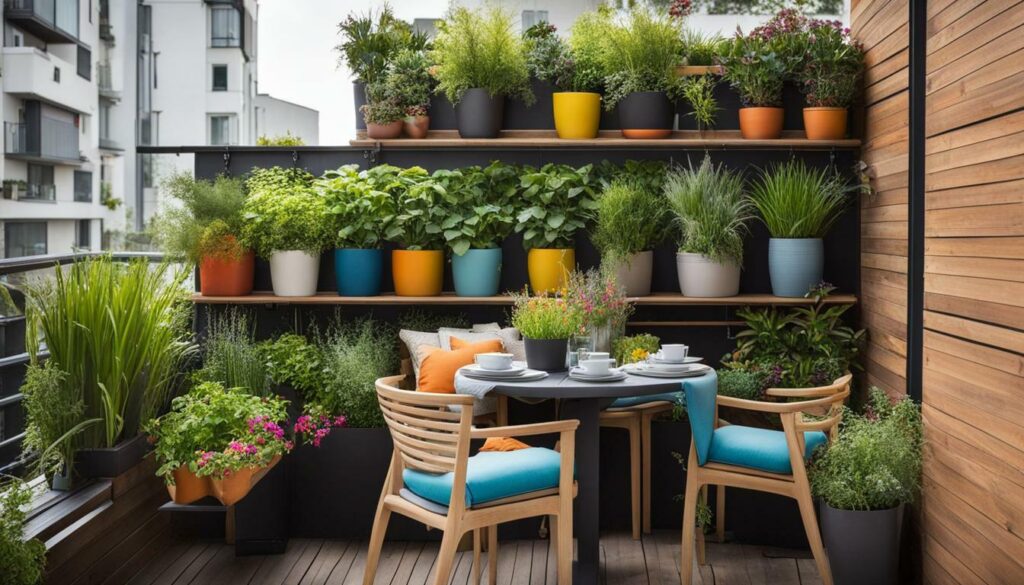
Maintenance and Care for Vertical Gardens
Like any garden, vertical gardens require regular maintenance and care to ensure healthy plant growth and maximize productivity. With proper attention, vertical gardens can thrive and provide an abundance of fresh produce and beautiful foliage. Here are some essential tips for maintaining and caring for your vertical garden:
- Watering: Vertical gardens may require more frequent watering compared to traditional gardens due to their vertical structure. Wall-mounted planters, in particular, can have a rain shadow effect, resulting in reduced rainfall reaching the plants. Consider installing a micro or drip irrigation system to ensure efficient water delivery and automate watering schedules.
- Fertilization: Vertical gardens benefit from regular fertilization to provide essential nutrients for plant growth. Choose a balanced organic fertilizer and apply according to the manufacturer’s instructions. Additionally, consider using slow-release fertilizers or incorporating compost into the soil to promote long-term soil fertility.
- Pruning: Regular pruning is important to maintain the shape and size of plants in a vertical garden. Remove any dead or diseased foliage, as well as excessive growth that may hinder air circulation. Pruning also encourages branching and can help improve overall plant health and productivity.
- Pest Management: Vertical gardens are not immune to pest infestations. Regularly inspect your plants for signs of pests such as aphids, mites, or caterpillars. Use organic pest control methods whenever possible, such as insecticidal soaps or neem oil, to minimize the impact on beneficial insects and the environment.
By following these maintenance and care tips, you can ensure the long-term success of your vertical garden. Remember to observe and respond to the specific needs of your plants, adjusting watering, fertilization, and other practices as necessary. With proper care, your vertical garden will thrive and provide a beautiful and productive space to enjoy.
Vertical Garden Maintenance Checklist
Here is a handy maintenance checklist for your vertical garden:
- Regularly check soil moisture levels and adjust watering accordingly.
- Monitor plants for signs of disease or pest infestation and take appropriate action.
- Prune plants to maintain shape and remove any dead or damaged foliage.
- Apply organic fertilizer according to the manufacturer’s instructions.
- Inspect and repair vertical structures, such as trellises or cages, as needed.
By following this checklist and giving your vertical garden the care it needs, you can enjoy a flourishing and productive garden all season long.
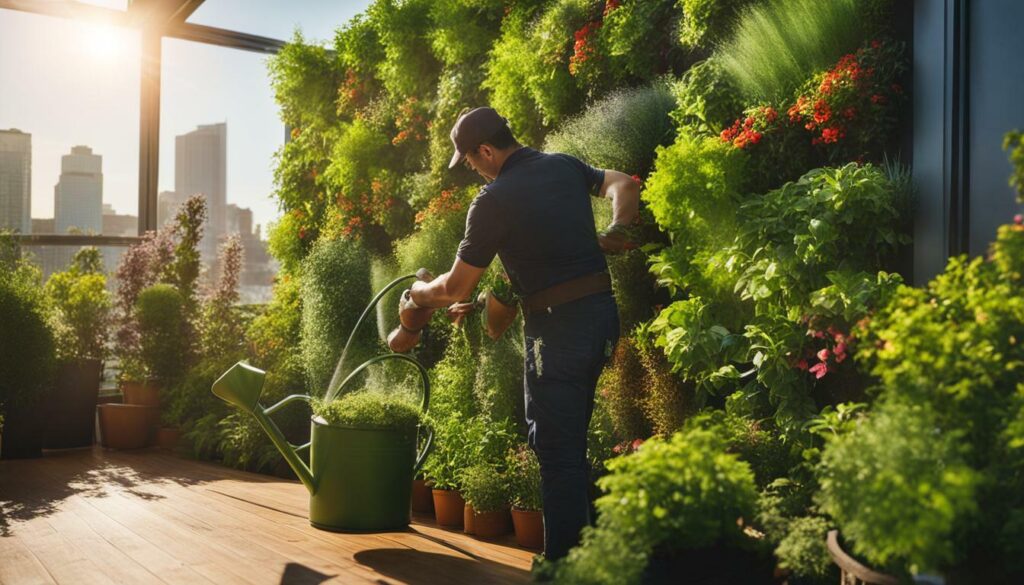
| Vertical Garden Maintenance Tips | Benefits |
|---|---|
| Regular watering | Ensures healthy plant growth and prevents dehydration |
| Proper fertilization | Provides essential nutrients for optimal plant health and productivity |
| Pruning and trimming | Maintains the shape and size of plants, improves air circulation, and promotes branching |
| Pest management | Prevents pest infestations and protects plants from damage |
| Inspection and repair | Keeps the vertical structures sturdy and prevents potential accidents |
Following these maintenance tips and incorporating them into your routine will help ensure the long-term success of your vertical garden. With proper care and attention, you can create a thriving and stunning vertical garden that will be the envy of your neighborhood.
Overcoming Challenges in Vertical Gardening
While vertical gardening offers many benefits, it’s important to be aware of and address potential challenges that may arise in the process. By understanding and overcoming these challenges, you can ensure the success of your vertical garden and enjoy a bountiful harvest.
Challenge 1: Watering Needs
Vertical gardens, particularly wall-mounted planters, may require more frequent watering compared to traditional gardens. The rain shadow cast by the wall can cause these planters to dry out quickly, especially during hot and dry weather. To overcome this challenge, consider installing micro or drip irrigation systems that deliver water efficiently and can be automated with timers for convenient and consistent watering.
Challenge 2: Soil Requirements
Choosing the right type of soil for vertical gardening is crucial for the health and productivity of your plants. The soil should be well-draining to prevent waterlogged roots, as excessive moisture can lead to root rot and other diseases. Consider using lightweight potting mixes or creating a custom soil blend that incorporates organic matter, such as compost, to improve soil structure and fertility.
Challenge 3: Choosing Appropriate Plants
Not all plants are suitable for vertical gardening. It’s crucial to select plants that have a natural inclination to climb or have vining growth habits. Some popular choices for vertical gardens include pole beans, climbing peas, vining tomatoes, and sprawling varieties of zucchini, cucumber, melon, and squash. These plants can be trained to grow upward with the help of trellises, cages, or other vertical structures.
| Plant | Varieties |
|---|---|
| Cherry Tomato | ‘Sungold’, ‘Black Cherry’, ‘Gardener’s Delight’, ‘Blondkopfchen’ |
| Cucumber | ‘Burpee Hybrid II’, ‘County Fair 83’, ‘Dasher 11’, ‘Saladin’ |
| Green Bean | ‘Romano Italian’, ‘Meraviglia Venezia’, ‘Gold of Bacau’ |
| Lima Bean | ‘Doctor Martin’, ‘King of the Garden’ |
| Melon | ‘Delicious 51’, ‘Tigger’, ‘Sleeping Beauty’ (musk melon); ‘White Wonder’, ‘Yellow Doll’ (watermelon) |
| Pea | ‘Dual’, ‘Garden Sweet’, ‘Maestro’, ‘Sugar Snap’, ‘Super Sugar Snap’ |
| Squash | Acorn, Delicata, Yellow Summer, Zucchini |
Challenge 4: Structural Support
Providing proper support for climbing vegetables is essential to prevent damage to the plants and ensure their vertical growth. Different types of vertical structures, such as trellises, arches, and cages, can be used depending on the characteristics of the plants. Leafy plants with tendrils, like pole beans and sweet peas, thrive on trellises, while more substantial plants, such as grapevines, may require sturdier structures like arches or pergolas. The structures must be well-anchored to prevent toppling.
By addressing these challenges and implementing appropriate solutions, you can create a successful vertical garden that maximizes your space and yields a diverse range of plants. With proper watering, soil preparation, plant selection, and structural support, you’ll be able to overcome any obstacles and enjoy the benefits of vertical gardening.

Vertical Gardening Indoors
Vertical gardening is not limited to outdoor spaces, and with the right conditions, it can be successfully implemented indoors, bringing nature and greenery into your home. Whether you live in an apartment, have limited yard space, or simply want to enhance the aesthetic appeal of your interior, vertical gardening provides an excellent solution for growing plants vertically.
One popular method of vertical gardening indoors is creating a living wall. A living wall is a trellis panel secured onto the wall, supporting a range of pots planted with herbs, vegetables, and flowers. It not only adds a touch of natural beauty to your indoor space but also maximizes your planting area. To create a living wall, choose an appropriate-sized panel, give it a coat of wood stain or paint for protection, and secure it to the wall using hooks. Plant low-growing crops like lettuce, herbs, or flowers in pots, spacing them evenly on the trellis and securing them with garden twine. Regular watering and harvesting are necessary to maintain the health and beauty of your living wall.
Another innovative idea for vertical gardening indoors is a vegetable arch. Using galvanized metal uprights and cattle panels, you can create a productive walk-through vegetable arch. Plant climbing crops like beans, cucumbers, and squash, and let them grow on the archway. Not only does this create a stunning visual element in your space, but it also provides easy access for picking your homegrown vegetables. With proper soil preparation and regular care, you can enjoy a bountiful harvest of fresh produce.
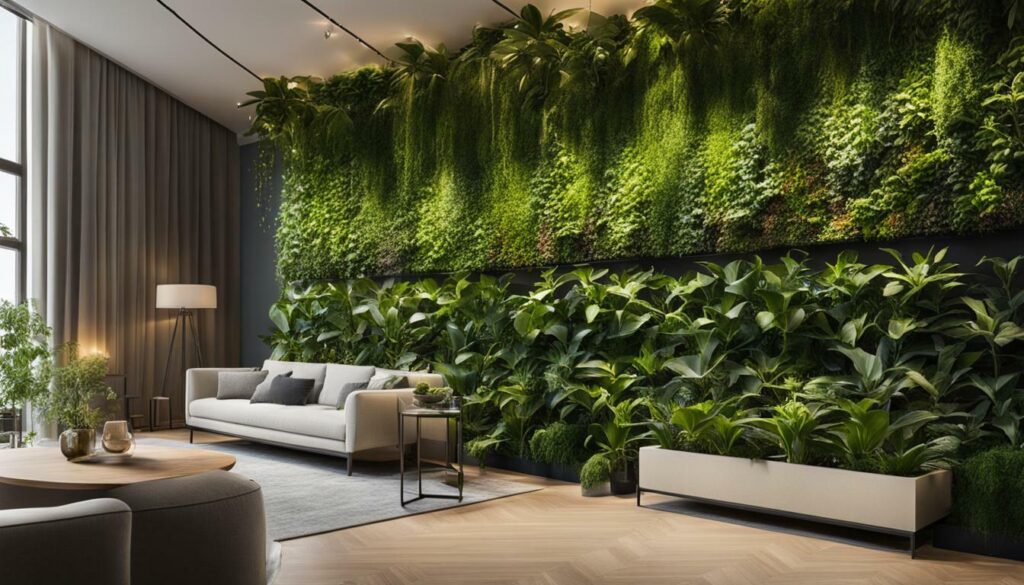
In addition to these specific ideas, there are numerous other ways to incorporate vertical gardening indoors. Shelving, wall hangers, and hanging mechanisms can be used to create vertical plant displays, utilizing the available space efficiently. Fences, arbors, trellises, and other types of structures can be placed indoors to support vertical garden plants. Hanging baskets can also be considered elements of vertical planting, adding depth and visual interest to your indoor garden. Attach a drip irrigation system for easy watering, or use a rope-and-pulley system for hanging baskets, making maintenance more convenient.
Vertical gardening indoors not only adds a decorative touch to your space but also offers the benefits of improved air quality, reduced stress levels, and a connection to nature. It is an excellent option for those with limited outdoor space or for those who want to bring the beauty of nature inside. Experiment with different plants, designs, and techniques to create your own unique vertical garden indoors.
Frequently Asked Questions
- Can all vegetables be grown vertically?
While not all vegetables are well-suited for vertical gardening, many climbing or vining vegetables thrive in this environment. Some popular choices include tomatoes, cucumbers, peas, beans, squash, and melons. It’s important to choose varieties that are suitable for vertical growth and provide the necessary support for their development. - What kind of support do I need for a vertical vegetable garden?
The type of support needed for a vertical vegetable garden depends on the specific plants you’re growing. Trellises, cages, stakes, and nets are commonly used to provide structural support for climbing or vining vegetables. The support structure should be sturdy enough to withstand the weight of the plants and their fruits. - Can vertical gardening improve the yield of my vegetables?
Yes, vertical gardening can help improve the yield of vegetables. By utilizing vertical space, you can grow more plants in a smaller area, increasing your overall harvest. Additionally, vertical growth allows for better air circulation and sunlight exposure, which can promote healthier plant growth and higher yields. - How do I water a vertical vegetable garden?
Watering a vertical vegetable garden can be done using various methods. Drip irrigation systems are efficient and can be automated with timers. Alternatively, you can hand-water the plants or use self-watering containers. It’s important to ensure that the plants receive adequate moisture, as vertical gardens may dry out more quickly due to increased exposure to sunlight and wind. - Is vertical gardening suitable for small spaces?
Yes, vertical gardening is particularly suitable for small spaces. By utilizing vertical space, you can maximize your planting area and grow a variety of plants even in limited space. It’s a great solution for balconies, patios, and other compact areas where traditional gardening may not be possible. - Can vertical gardens be grown indoors?
Yes, vertical gardens can be successfully grown indoors. With proper lighting, adequate air circulation, and the right plant selection, you can create a stunning vertical garden in your home. Indoor vertical gardens can enhance the aesthetic appeal of your space, improve indoor air quality, and provide the joy of gardening year-round. - What are some challenges of vertical vegetable gardening?
Some challenges of vertical vegetable gardening include the need for regular watering, ensuring proper sunlight exposure, and providing adequate structural support for the plants. Additionally, choosing the right plants and managing pests and diseases can be important factors in the success of vertical gardening. - Do I need any special soil for vertical gardening?
While special soil is not always necessary for vertical gardening, using a well-draining, nutrient-rich soil mix can promote healthy plant growth. It’s important to ensure that the soil retains enough moisture while allowing excess water to drain to prevent waterlogging. Adding organic matter or compost can help improve soil fertility and moisture retention. - How often should I fertilize my vertical garden?
The frequency of fertilizing a vertical garden depends on the specific plants being grown and the nutrient requirements of the soil. It’s generally recommended to fertilize regularly throughout the growing season using a balanced, slow-release fertilizer or organic compost. Follow the instructions provided by the fertilizer manufacturer or consult a gardening expert for specific recommendations.
Recommended Products
| Product | Description | Price |
|---|---|---|
| Living Wall Trellis Panel | An attractive trellis panel for creating a living wall indoors. | $34.99 |
| Vertical Vegetable Arch | A sturdy archway for growing climbing vegetables indoors. | $59.99 |
| Drip Irrigation System | An efficient system for automating the watering of your vertical garden. | $29.99 |
| Organic Potting Soil Mix | A nutrient-rich soil mix for healthy plant growth. | $14.99 |
| Slow-Release Fertilizer | A balanced fertilizer for providing essential nutrients to your plants. | $9.99 |
Conclusion
Vertical gardening is a versatile and practical solution for gardeners looking to make the most of their outdoor space while growing a wide range of plants, herbs, and vegetables. By utilizing vertical structures such as trellises, cages, and arches, gardeners can maximize their growing area, increase yields, and reduce plant problems.
The benefits of vertical gardening are numerous. Firstly, vertical gardening allows for increased yields as it makes maximum use of available space. Plants grown vertically are also easier to maintain and harvest, as they reach higher levels, minimizing the need for bending and kneeling. Additionally, vertical growth provides better air circulation, reducing the risk of disease and pests and leading to healthier plant growth.
When it comes to choosing the right plants for vertical gardening, vining vegetables and herbs are excellent choices. Vining vegetables such as pole beans, climbing peas, and vining tomatoes can easily be trained to grow up trellises or cages, saving horizontal space. Similarly, herbs like climbing rosemary, thyme, and mint can thrive in vertical gardens, adding both beauty and flavor to your space.
Designing vertical structures for climbing vegetables is an important aspect of vertical gardening. Trellises, arches, and cages are popular options that provide sturdy support for the plants. It’s essential to match the structure with the plant’s characteristics and ensure it can accommodate the weight of mature plants.
Vertical gardening offers endless possibilities for growing various fruits and vegetables. From cherry tomatoes and cucumbers to peas and squash, there are numerous options to choose from. These plants can be successfully grown in vertical gardens, providing ample harvests and adding vibrant colors and flavors to your meals.
To ensure successful vertical gardening, it’s important to follow some practical tips. Proper watering, providing sufficient sunlight, regular pruning, and implementing effective pest control measures are key to maintaining a healthy vertical garden. Additionally, incorporating creative DIY vertical gardening ideas, such as living walls and trellis panels, can add visual appeal to your garden.
Vertical gardening is particularly beneficial for small spaces, including balconies, patios, and small yards. It allows individuals to maximize their growing potential in limited areas and enjoy the beauty of a lush garden even with limited space. With careful planning and selection of appropriate plants and structures, vertical gardening can transform even the smallest of spaces into green oases.
Maintaining and caring for vertical gardens requires attention to watering schedules, fertilization, pruning, and pest management. Regular maintenance is essential to keep the plants healthy, productive, and free from diseases and pests. By following proper care techniques, vertical gardens can thrive and provide bountiful harvests.
While vertical gardening offers many benefits, it also comes with certain challenges. Adequate watering is crucial for vertical gardens, especially wall-mounted planters that may require more frequent watering due to the rain shadow effect. Additionally, choosing the right plants that can thrive in specific growing conditions and ensuring proper soil requirements are met can pose challenges for vertical gardeners.
Lastly, vertical gardening can also be done indoors, providing an excellent solution for those with limited outdoor space or wanting to create green spaces inside their homes. Indoor vertical gardens can be achieved using various techniques, including living walls and vertical plant walls. Proper lighting and humidity control are key factors to consider when growing plants vertically indoors.
In conclusion, vertical gardening is a practical and versatile approach to gardening that offers numerous benefits. From increasing yields and reducing plant problems to maximizing small spaces and creating beautiful living walls, vertical gardening allows for the growth of a wide range of plants. With the right plant selection, structures, and care techniques, individuals can enjoy the pleasure of gardening while making the most of their available outdoor or indoor space.
Are the Plants Suitable for a Standing Vertical Garden the Same as a Traditional Vertical Garden?
Yes, standing vertical garden options are similar to traditional vertical gardens in terms of plant suitability. Most plants that thrive in traditional vertical gardens, such as succulents, herbs, and ferns, can also be used in standing vertical gardens. Consider the specific light and water requirements of each plant for best results.
FAQ
Q: What are some of the best plants for a vertical vegetable garden?
A: Some of the best plants for a vertical vegetable garden include vining vegetables like zucchini, tomatoes, cucumbers, peas, pole beans, squash, melons, eggplants, and more.
Q: Can all vegetables be grown vertically?
A: Not all vegetables are well-suited for vertical gardening. Vining, climbing, and sprawling plants tend to be the best candidates for vertical growth as they can be trained to grow up and off the ground.
Q: What kind of support do I need for a vertical vegetable garden?
A: Vertical vegetable gardens can be supported by various structures such as trellises, arches, cages, netting, bamboo poles, and more. The choice of support depends on the characteristics of the plants being grown.
Q: Can vertical gardening improve the yield of my vegetables?
A: Yes, vertical gardening can increase yields by making maximum use of space and allowing plants to grow upwards. It also provides better air circulation, reduces disease risk, and makes harvesting easier.
Q: How do I water a vertical vegetable garden?
A: Vertical gardens, especially wall-mounted planters, may require more frequent watering. Micro or drip irrigation systems can be used to efficiently deliver water and can be automated with timers.
Q: Is vertical gardening suitable for small spaces?
A: Yes, vertical gardening is ideal for small spaces as it maximizes growing area by utilizing vertical space. It is a great solution for balconies, patios, and small yards.
Q: Can vertical gardens be grown indoors?
A: Yes, vertical gardens can be grown indoors using structures or living walls. They are a popular choice for apartment dwellers and can help filter indoor air pollutants.
Q: What are some challenges of vertical vegetable gardening?
A: Some challenges of vertical vegetable gardening include ensuring proper support for plants, providing sufficient water and fertilizer, managing pests and diseases, and choosing appropriate plants for specific growing conditions.
Q: Do I need any special soil for vertical gardening?
A: While not necessarily required, using a well-draining and nutrient-rich soil mix is beneficial for the health and growth of plants in a vertical garden.
Q: How often should I fertilize my vertical garden?
A: Fertilization frequency depends on the specific needs of the plants being grown in the vertical garden. It is recommended to follow the instructions on the fertilizer packaging or to consult with a gardening expert.

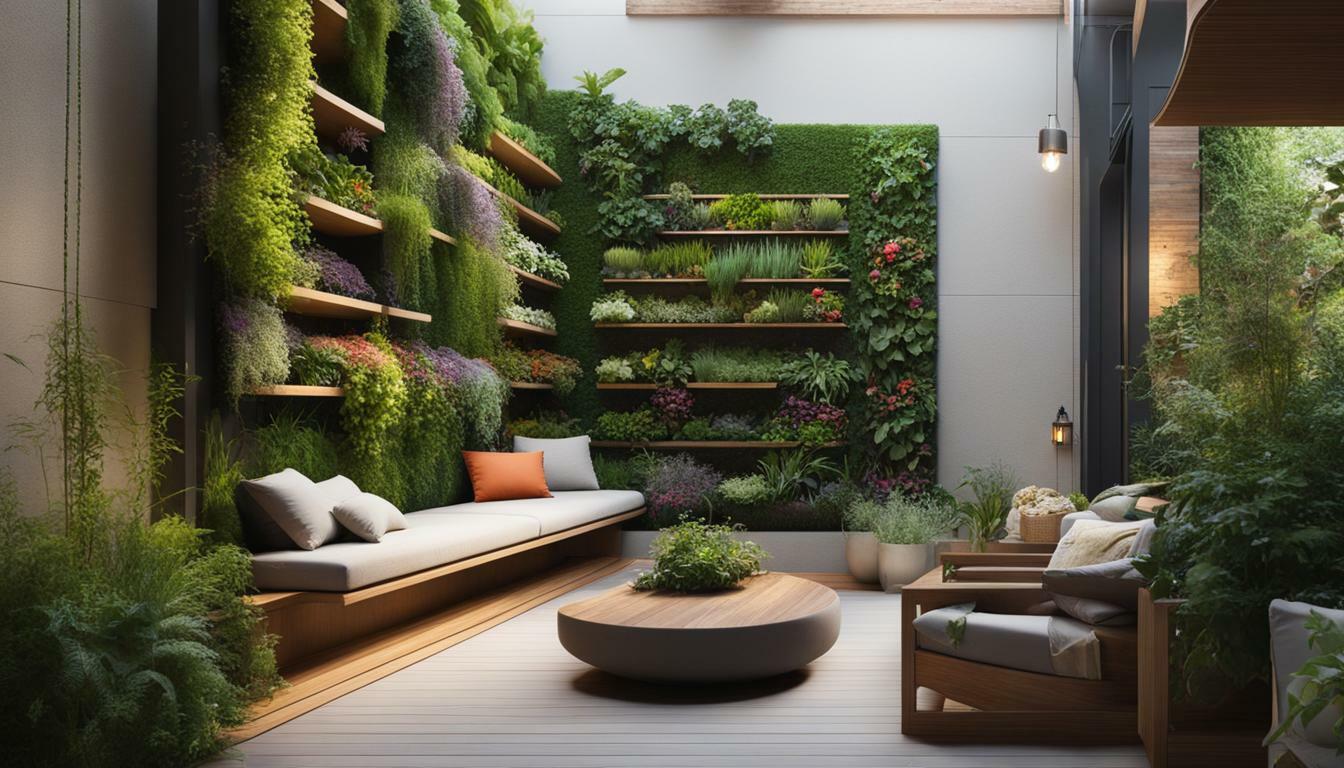
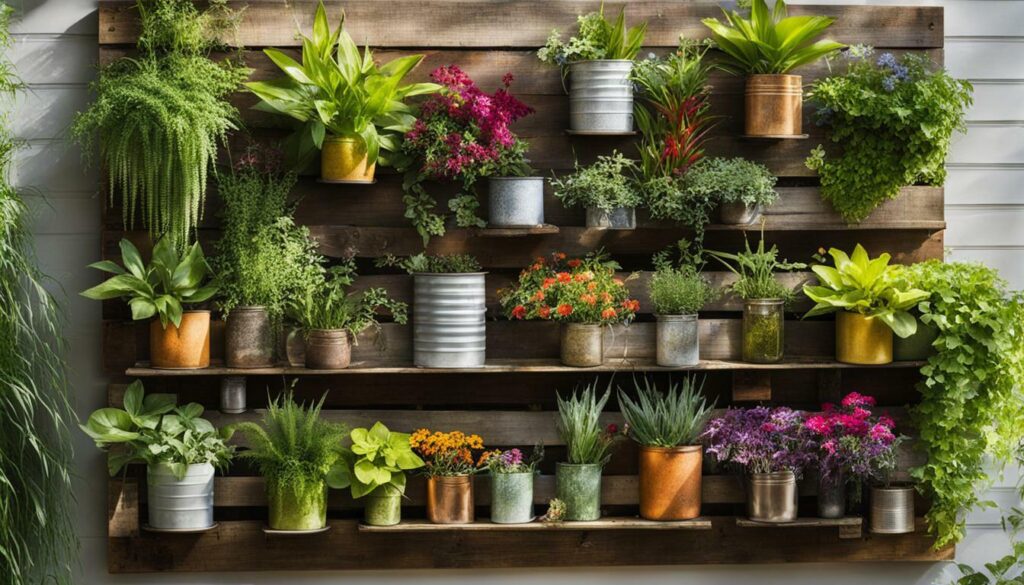 Vertical Garden with Recycled Items
Vertical Garden with Recycled Items